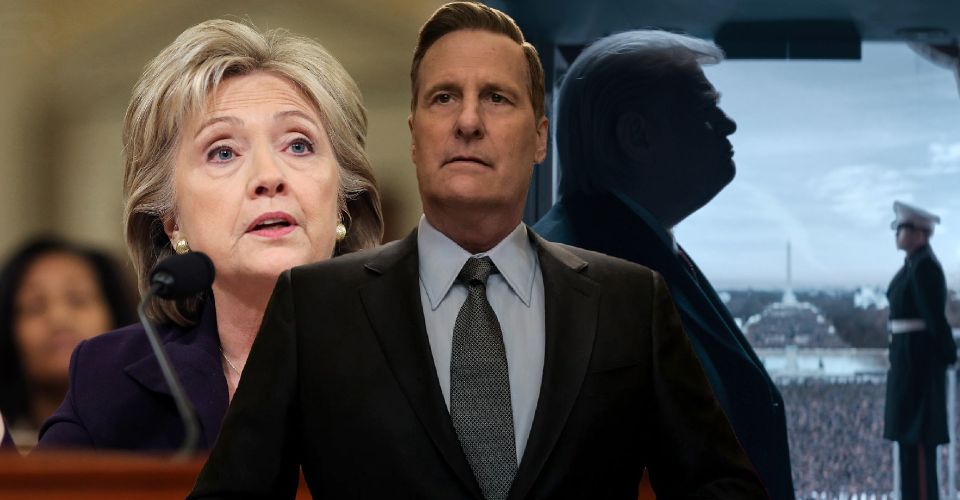Comey Rule True Story: What’s Fact & Fiction About Trump, Clinton, & Russia

Here’s what’s fact and what’s fiction in Showtime’s The Comey Rule. While the 2020 U.S. election season is ramping up toward its conclusion, the two-part political tragedy looks to tell the true story behind the headlines. And though it is a dramatization it has strong roots in the public record; after all, everyone watching is still living the reality.
Based on a 2018 memoir by former FBI Director James Comey (A Higher Loyalty: Truth, Lies, and Leadership), The Comey Rule is meant to serve as an insider’s look into the 2016 email scandal and the ensuing tidal wave that swept away its subject. As with most fictionalizations, The Comey Rule takes some liberties for the sake of storytelling, but it also makes the most of the idiosyncrasies that have been revealed through the exposés and interviews in the intervening years. For the armchair pundit crowd, “Night One” contains plenty of familiar names from the news reports and opinion shows, while deftly introducing the key players and checking off historical plot points. On the other hand, “Night Two” attempts to contain the story’s Nosferatu, the newly-elected President Donald Trump, as Jeff Daniels’ Comey tries, and fails, to expose him to the sunlight.
In addition to Daniels as the story’s central figure, The Comey Rulestars a number of recognizable actors skillfully portraying contemporary public figures, most notably Irish actor Brendan Gleeson as President Donald J. Trump. Also featuring strong character actors Holly Hunter, Michael Kelly, and Scoot McNairy in the supporting roles of expelled officials, the miniseries aims to provide a clearer look into the murky months on both sides of Trump’s election. So, how close to the truth does The Comey Rule adhere, or better yet, how much of it is “fake news?”
The Comey Rule Aces The Headlines (At The Expense of Details)

At its heart, The Comey Rule is a shrewd procedural adaptation of a real-life American fever dream, which makes sense, considering a life-long bureaucrat wrote the source material. Comey’s memoir itself exists thanks to the former FBI head’s propensity to take extensive notes, one of the many quirks the series sneaks into the story. Between Comey’s text and the bounty of reporting by news organizations, the entire Trump v. Clinton saga is a rollercoaster propelled by jet fuel, but The Comey Rule manages to pack the essential highs and lows of the affair into a manageable if bumpy ride. Contemporary clips from the major news outlets are used artfully to advance the plot, but more so they serve as a vivid reminder of the show’s basis in a reality that is in the film’s post-script. Like a greatest hits compilation of gut-punches, the show delivers the highlights from the time surrounding the uneasy election of the world’s most volatile wild card.
Though the words may not be verbatim all the time, clever viewers can recognize the realism of the language used by its two primary subjects. Jeff Daniels takes Comey’s documented words and expounds stoically from there, reinforcing his carefully manicured image as a paragon of rules and regulations. If you read A Higher Loyalty cover to cover, you’ll find yourself subject to a few ethics lessons from the man who tried too hard to appear impartial. TV’s Jim Comey is a walking, talking civics course, complete with semi-sanctimonious lectures delivered contently by Daniels. Similarly, Brendan Gleeson transcribes the President’s public and private dialogue with Trump’s signature smarm. The show sticks closely to Comey’s accounting of the one-on-ones with Trump, including the unscheduled meeting between the two where they discussed “letting go” of the investigation of General Michael Flynn (played by William Sadler). In one of the show’s peaks of tension, the infamous private dinner between the two is portrayed like an interrogation being run by the inmate. And the audience can only rely on the account of the high-minded Comey for accuracy.
Everybody Was (Probably) Worried

Interestingly, The Comey Rule accurately conveys the anxiety and queasiness attached to the whole ordeal. As Comey waffles on Hillary Clinton’s email servers, the tension rises – and it continues to rise with every real-life event that is painfully relived. The advantage of the insider’s perspective is the revelation that those same insiders were just as anxious as the rest of America. Many of the officials portrayed in The Comey Rule have either written their own books, joined the ranks of cable news, or both, and the consensus seems to be that everyone was worried but nobody had the gumption to do anything about it. Former FBI agent Peter Strzok (here played by Steven Pasquale) has provided just one such account into the chaos that surrounded Operation Crossfire Hurricane, and it’s fraught with worrisome distress. Of course, he and Lisa Page (played by Oona Chaplin) had other things to worry about; the show briefly explores the affair between the two, another source of sub-controversy.
These worries were of course very well-founded, as Trump’s arrival in Washington slowly resulted in the expulsion of those tasked with investigating him (which plays out in the show’s droll epilogue). According to another former FBI director, Andrew McCabe (played by House of Cards‘ Michael Kelly), Trump really tossed in an insult to his wife as a prelude to his inevitable firing. In McCabe’s own reflection entitled The Threat (one of several related books the show likely draws from), he describes the President as untrustworthy; Comey compared Trump to the contemporaneous mobster Sammy “The Bull” Gravano. The Comey Rule reinforces the panicked indecision officials like Comey, McCabe, and others only reported after receiving their walking papers.
The Comey Report Treads Lightly On Russia

The only specter that looms almost as large as Trump is the spirit of Russian hijinks. While the nation was consumed by an email-related meltdown, the FBI was tasked with genuine suspicions of foreign interference in the U.S. elections; the combination winds up screwing Comey. The Comey Rule is quite careful when it comes to insinuating actual interference on America’s shores, settling on two non-descript Russians toasting a job well done. Between Comey’s book and the Mueller Report, the series has enough source material to paint an accurate, and damning, picture of events regarding Trump associates’ misdeeds. If anything, the show adds a bit of panache when recalling George Papadopoulos drunkenly spilling the beans on Russian collusion. Likewise, the scenes of Gen. Flynn’s adventures in Moscow might be a little exaggerated to emphasize his ineptitude for truth-telling. There’s no “smoking gun” in Vladimir Putin’s hand, but The Comey Rule depicts an FBI director with enough suspicions to look deeper, and an agency that tried, but failed, to finish his work.
Rod Rosenstein Is Not A Reliable Narrator

The Comey Rule is framed through the eyes of yet another excoriated official, former Assistant Attorney General Rod Rosenstein (played by Scoot McNairy), as he reflects to a staffer on his way out of Washington. Unfortunately, here he serves as both unreliable narrator and Comey’s sole critic. In playing the storyteller role, McNairy’s Rosenstein makes comparisons between Comey and the FBI’s most infamous director, J. Edgar Hoover, indicating that the former lacked the humility of the agency’s original Judge Dredd. Ultimately, The Comey Rule’s biggest falsehood lies in the lengths it takes to pass judgment on its subject. While disdain for Trump is part of the public record, the show thinks out loud for its audience, assuming they won’t empathize with someone as morally straight as Comey. It’s also doubtful that Rosenstein would include his own rumored gaffes in retelling the tale; the real Rod denies offering to wear a wire whilst crying to McCabe.
The truth even Rosenstein can hardly deny is that James Comey may be self-righteous, but his is the only moral compass that still pointed true among those in the President’s orbit. The Comey Rule sticks to the story as Jim sees it, but writer-director Billy Ray makes sure to convey the anti-Comey sentiment that followed the 2016 mess. It is true that his wife and children were Hillary supporters, but the real James Comey never wrote about explaining his actions to them. When he’s challenged to a duel with Donald Trump, his virtue becomes his vice, and he loses. In this way, the series attempts to fortify the notion that TV’s Comey was just playing by the rules of the game, while his subordinates accuse his ego of running amok. Ultimately, The Comey Rule is a mostly accurate depiction of the subject’s perspective, but the show never stops reminding the viewer that Comey is a very serious customer.
About The Author

















